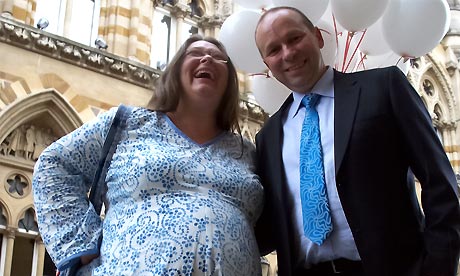
It is Christmas Day and two women wear silly paper hats as they grin at the camera, the hand of one placed protectively on the pregnant stomach of the other. It could be just any other family snap until you read the caption alongside, which explains that the baby, Otis, died just 20 minutes after being born.
There are 16 more ordinary family snaps, including the one above, shown alongside this framed photo in an extraordinary exhibition designed to raise awareness of a subject that is so taboo that few like to talk of it. Each day, 17 babies die before, during or shortly after birth in the UK. That's one in every 200 births, a rate that has stuck at that level since 1999.
Given the devastating nature of the loss, friends and family alike find it difficult to talk about. Those affected say they are most often told that "these things happen" or "Never mind, you can always have another one." The chance of a stillbirth is judged to be so low that pregnant women are rarely given access to information about support services. Yet the stillbirth rate in the UK is one of the worst in Europe, higher than 17 EU countries, including Malta, Slovenia and the Czech republic. And nobody really knows why.
When John Kemp and his wife lost a baby boy, Alexander, at 33 weeks and 3 days, they felt isolated in their grief. "People crossed the street when they saw us coming," says Kemp. "And it's precisely because it is so hard to talk about we need to raise awareness that this is happening. And we need to find out why."
In a series on stillbirth earlier this year, the medical journal the Lancet refutes the popular assumption that a stillborn baby suffered some sort of congenital abnormality. In fact, this affects just 5% of the 2.6m babies stillborn worldwide in 2009.
A report by my colleague Sarah Boseley earlier this year suggests that a third of stillbirths are unexplained here with poor NHS maternity care thought only partly to blame. Other factors, such as the age and health of the mother, also fail to explain the rate.
The lack of information prompted Kemp to contact Sands and ask the stillbirth and neonatal death charity to contact others interested in raising awareness. In total, 50 families sent in more than 100 photographs, 17 of which are shown at the Oxo gallery in London with the support of Sands and other benefactors.
Anne Milton, public health minister, addressed the exhibition opening this week and urged guests to contact their local MP. "We need to make a difference to this issue," she said.
In an introduction to the exhibition's brochure, Kemp described what he hoped to achieve by putting his private grief into the public arena. "Perhaps you will be shocked at how frequently baby death occurs. Perhaps it will give you the courage to say something to somebody you know who has experienced this anguish. Maybe it will help you think about our response as a society… Only you can decide if 17 has been successful and how you would like to respond."
The 17 Exhibition runs until 12 December. It's one of the most moving, thought-provoking exhibitions I've seen. Go and see it – details here.

